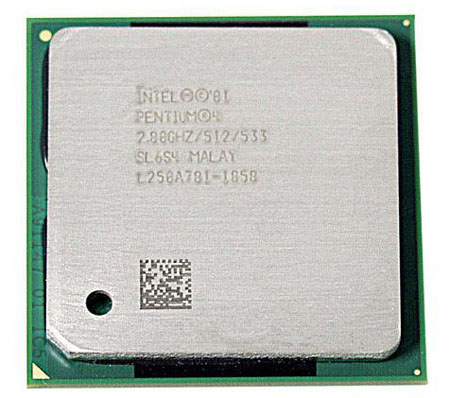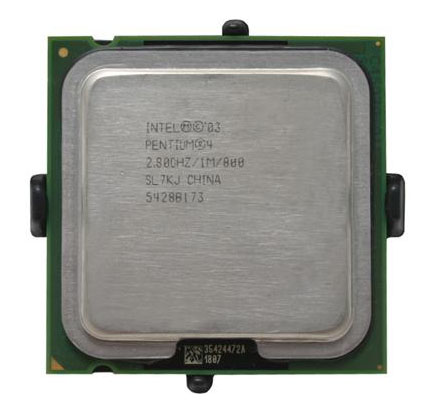Processor Obfuscation and You: An Update on AMD and Intel CPUs
by Kristopher Kubicki & Jarred Walton on May 17, 2005 12:00 PM EST- Posted in
- CPUs
Intel Processors
With AMD out of the way, we'll move on to the code names and features of all the currently shipping Intel processors. We only have two platforms this time - not counting the server and mobile options. The good news is that there isn't quite as much overlap in the Intel world. Sure, we have numerous chips running at similar clock speeds, but with a few exceptions, each model number explicitly defines one set of features. Where AMD has four different Athlon 64 3400+ chips (including the obscure 2.2 GHz 512K 939 chip that is limited to an 800 MHz HyperTransport link), the Intel Pentium 540J is always a 3.2 GHz Prescott core for socket 775. Let's take a look at the shipping cores.| Intel Processors | ||||
| Core Name | CPU Name | L2 Cache | Process | Notes |
| Socket 478 | ||||
| Northwood | Celeron | 128K | 130nm | No SSE3 |
| Northwood | Pentium 4 | 512K | 130nm | No SSE3 |
| Prescott | Celeron D | 256K | 90nm | |
| Prescott | Pentium 4 | 1024K | 90nm | |
| Socket (LGA) 775 | ||||
| Prescott | Celeron D | 256K | 90nm | Partial EM64T |
| Prescott | Pentium 4 5xx | 1024K | 90nm | Partial EM64T |
| Irwindale | Pentium 4 6xx | 2048K | 90nm | |
| Cedar Mill | Pentium? | 2048K | 65nm | |
| Smithfield | Pentium D | 2 x 1024K | 90nm | Dual Core |
| Presler | Pentium D? | 2 x 2048K | 65nm | Dual Core |
Socket 478

For 2.8 GHz and above, we'd say look to overclocking first (if you haven't already), and if you're still unsatisfied, you'll probably want to ditch the platform rather than investing more money. Those running anything less than a 2.6 GHz chip might consider purchasing one of the faster chips before they entirely disappear, but you're basically delaying the inevitable. Unlike AMD, however, socket 775 doesn't offer a whole lot in the way of improved performance. DDR2 and PCI Express won't be available without switching to socket 775, but they're not truly necessary. We wouldn't spend a whole lot of money on a new AGP card, but if you already have something reasonably powerful, you're probably best off waiting a bit longer to upgrade from anything sporting an 865PE or 875P chipset (or else jumping ship and purchasing an AMD system).
Socket 775

The next Intel core is Smithfield, which received its official name with the recently released Pentium D processors - although really, we should call them "the recently announced" Pentium D processors, as they are not yet available for purchase at any retailers. (That should hopefully change in the next month.) Smithfield processors will use 8xx model numbers to differentiate them from their single core relatives. Like the 6xx series, the 8xx processors all feature support for EIST and EM64T, but they add a second core. Multitasking in particular stands to benefit a lot from the addition of a second core, but for running a single-threaded application (without a bunch of other processes), a higher clocked 5xx or 6xx chip is still going to be faster. The Extreme Edition also has HyperThreading enabled, allowing the execution of four simultaneous threads. Unfortunately, HyperThreading is not always beneficial, as there are cases where the Pentium Extreme Edition 840 is outperformed by the Pentium D 840.
There are drawbacks for Pentium D: heat output and power consumption. The power draw of a Pentium D system scales rapidly with increased clock speeds. In order to combat this, Intel has been forced to reduce the shipping clock speeds of their dual core chips. This means that while 3.6 and 3.8 GHz parts are available for the 5xx and 6xx lines, the fastest 8xx chip is currently 3.2 GHz. Sure, the relative power draw of Pentium D may only be 15% higher than Pentium 4, but when you're talking about 100+ Watts, removing an additional 15% can become difficult. You could also say that the lower clock speeds tie into the more affordable prices that Intel is presenting. Where AMD is essentially releasing dual core variants of their 3500+ and higher processors, Intel is only releasing 2.8 to 3.2 GHz parts. If AMD had 1.8 and 2.0 GHz dual core parts, the prices might be quite a bit lower.
Even with these drawbacks, the Pentium D is still an attractive part for many people. The biggest problem is that the Pentium D is not yet available for purchase, and while it uses the same socket (LGA 775), you need a motherboard with one of the new 945/955 Intel chipsets. (The NVIDIA nForce 4 SLI chipset will also work, provided that the motherboard manufacturer has designed their board properly.) If you're serious about purchasing a new computer and you're set on an Intel system, we would strongly recommend waiting for the new motherboards and processors to become available.










55 Comments
View All Comments
Son of a N00b - Tuesday, May 17, 2005 - link
Great Article!Quanticles - Tuesday, May 17, 2005 - link
I think all of the confusion would be helped if you stopped using the marketing names.If people would just call them by their rev numbers... I have a D0 part... less confusion, no?
JBird7986 - Tuesday, May 17, 2005 - link
#9,I don't think anything was forced. As soon as I booted up the system for the first time, the HyperTransport link read 1000MHz with no input from me. It would seem then that the 800MHz spec is inaccurate.
webchimp - Tuesday, May 17, 2005 - link
I was just coming round to the idea of upgrading my Athlom XP Socket A, AGP system to a Socket 939 PCI-E based one when I hear mention that socket 939 is to be replaced by socket M2 in about a year.The possibility of buying a motherboard with the ability to upgrade to more powerful CPU a couple of times within it's lifespan seems to be going out of the window.
Zebo - Tuesday, May 17, 2005 - link
Kris or JarredWhy hav'nt we seen any San Diego or Venice reviews from you guys... In fact I've scoured the web and hav'nt found one San Deigo review... 3700 would be nice.
Zebo - Tuesday, May 17, 2005 - link
Very helpful gentlemen.:-)johnsonx - Tuesday, May 17, 2005 - link
Good article, thanks Guys.Minor typo on the last page: "We would strongly recommend a socket 939 or one of the new (Intel 845/855 or NVIDIA nForce 4 SLI chipsets) socket 775 systems...". Obviously you meant Intel 945/955.
#2: you may be able to force the HT link to 1000Mhz, but the fact remains that the processor is spec'd for 800Mhz, and it is obscure. I only saw them for sale at newegg for a few weeks it seems.
JarredWalton - Tuesday, May 17, 2005 - link
Just FYI, the article went live early. Sorry if you see this. Check back at noon tomorrow.bob661 - Tuesday, May 17, 2005 - link
Scratch that. Windsor is on the new socket. I'll get the 4800 instead.bob661 - Tuesday, May 17, 2005 - link
I think I'll buy a new video card within the next 4-6 months and upgrade to a Windsor core CPU next summer.